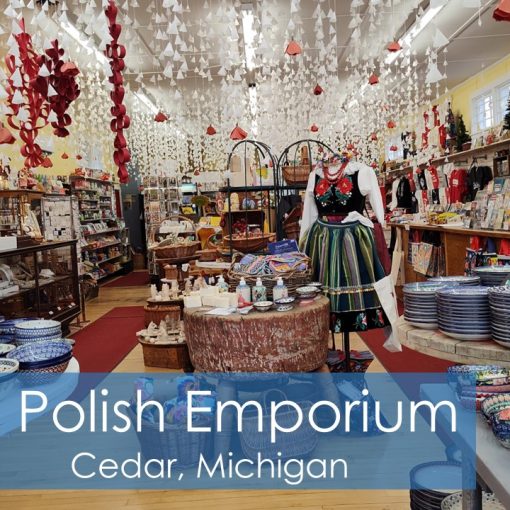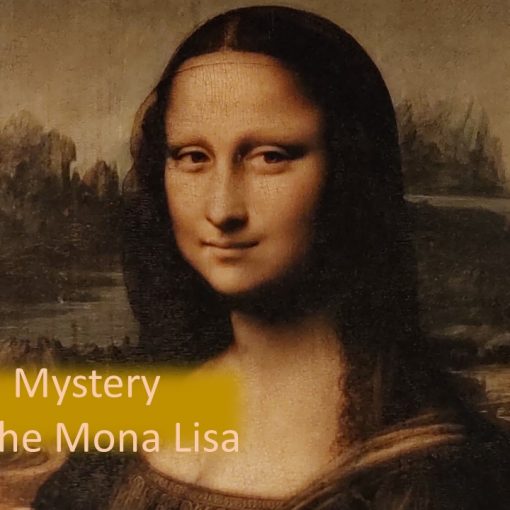How did Mardi Gras become part of New Orleans culture? We were curious. Da Viking and I wanted to look behind the curtain to learn more. We started our New Orleans caper by visiting Blain Kern’s Mardi Gras World. This large studio houses year-round float construction.

As we approached the entrance, we heard a train whistle and noticed the flood gate. Soon the red warning lights began blinking and the chiming bells had started. The locomotive, hauling an enormous collection of cars, rumbled in front of the entranceway to the workshop.



After the parade of cars passed, we entered Mardi Gras World’s gift shop. Kelly sold us self-guided tour “tickets” which were strings of Mardi Gras beads. A magical world awaited us behind a steel door!
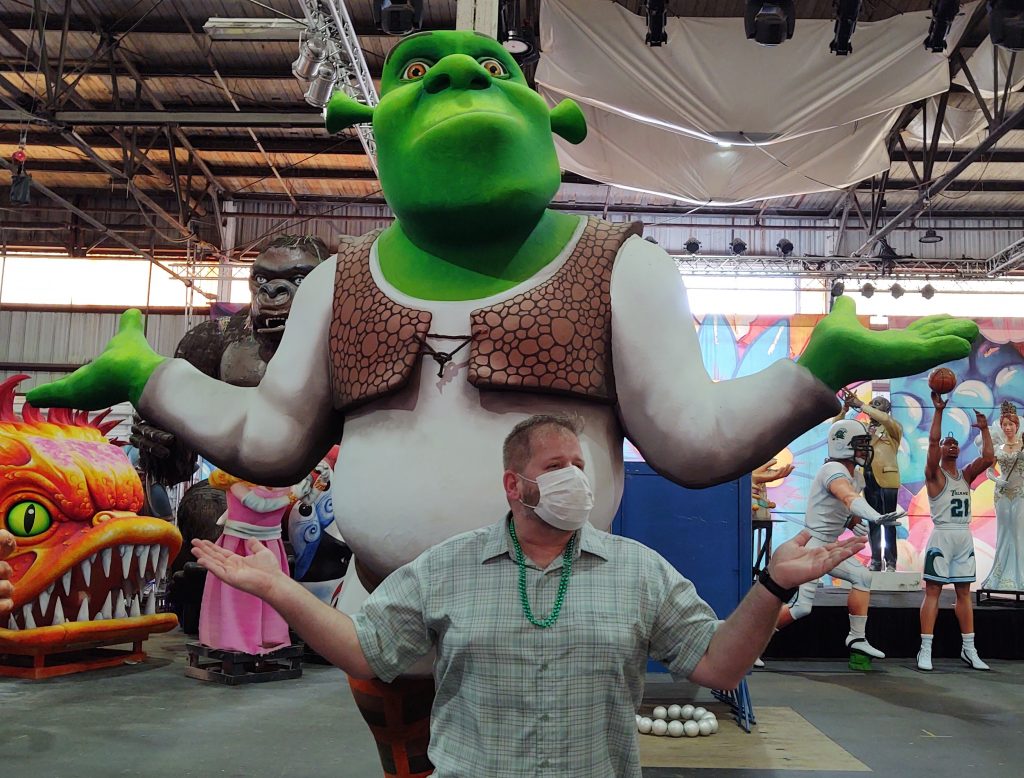
I felt like Alice in Wonderland as we meandered among the cluster of characters.
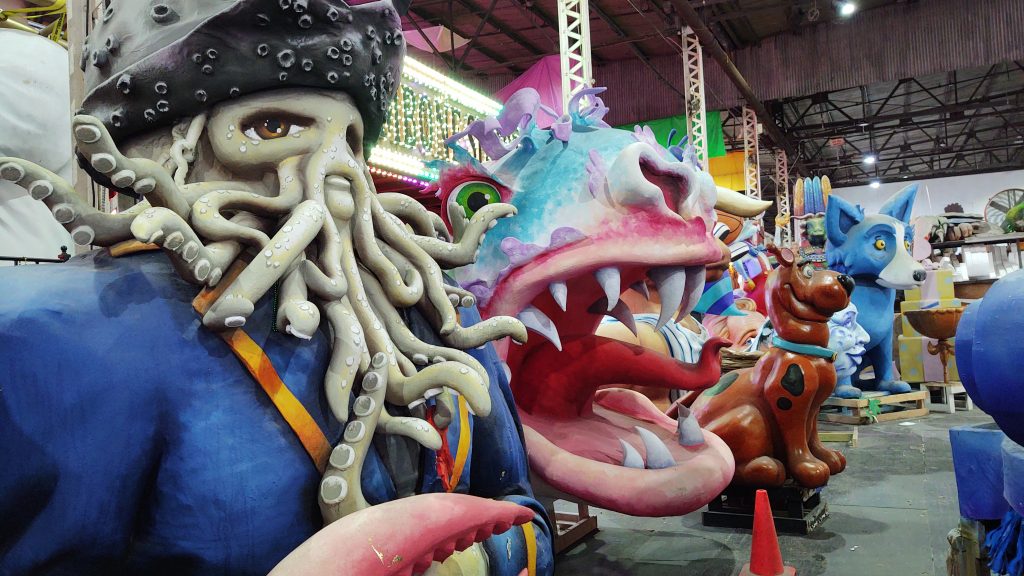
and the “bity fish,” but soon he ran to Scooby Doo asking, “Where’s Shaggy?”
How do these festive floats fit into the tradition of Mardi Gras? How did this all start?
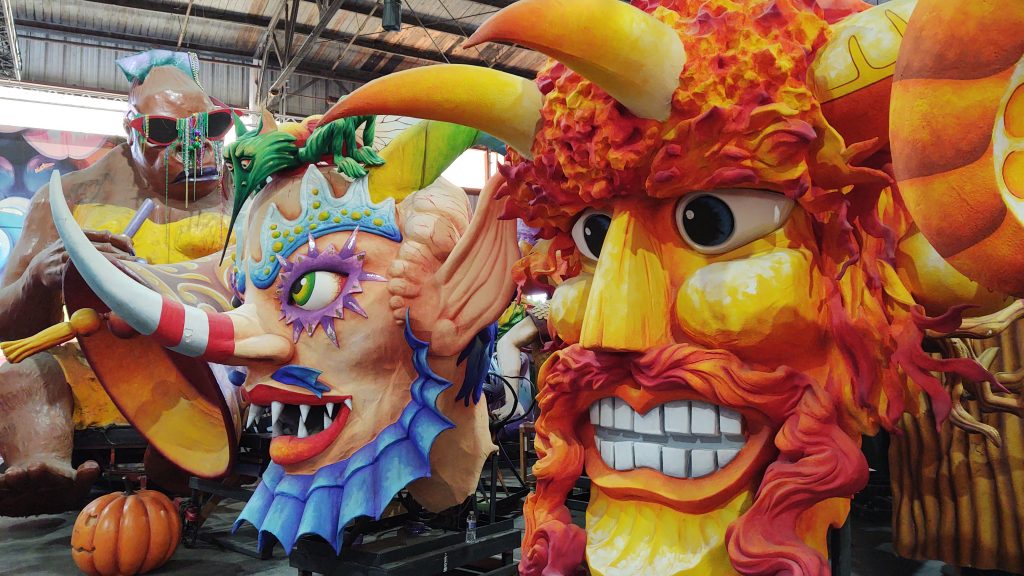
The Mardi Gras Carnival is a tradition dating back to medieval Europe. It is a time of extravagance before Lent. Lent marks the forty days that Jesus spent in reflection and prayer before his crucifixion.
These celebrations have been known as “carne val” which is translated as “meat goes.” For centuries springtime meant the stored, frozen meat would need to be cooked and eaten, otherwise it would spoil. Then, in the following weeks there would be a lack of animal protein in their diet. This annual event became part of the Lenten tradition.
So this custom of extravagance before the Lent has been centuries old. Many Roman Catholics still follow the strict guidelines of fasting during these Lenten days or at least refrain from eating meat on Fridays.
Flashback:
Da Viking and I recalled our first “Carne val,” although we didn’t have a clue about what was happening at the time. We had arrived in Caglari, Italy on the island of Sardinia in February 2020. We heard drumming and chanting from our balcony. Soon the thundering chorus neared us, so we headed out to the street to investigate. The entire avenue was filled with clowns! Yes, clowns! Young and old painted faces were marching through the streets. They were costumed and caroling in their Sardinian language.
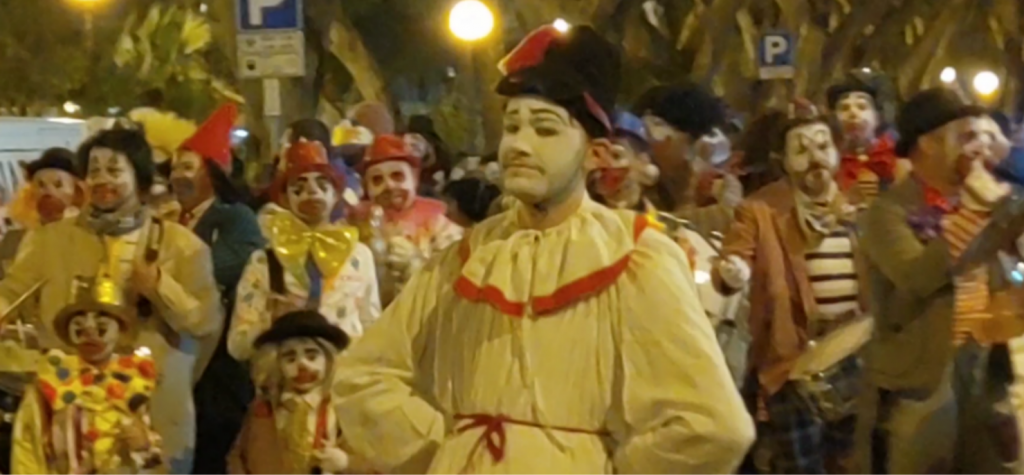
Children and adults dressed up as clowns and marched through the streets.
We’d never experienced a lively costumed crowd like this!
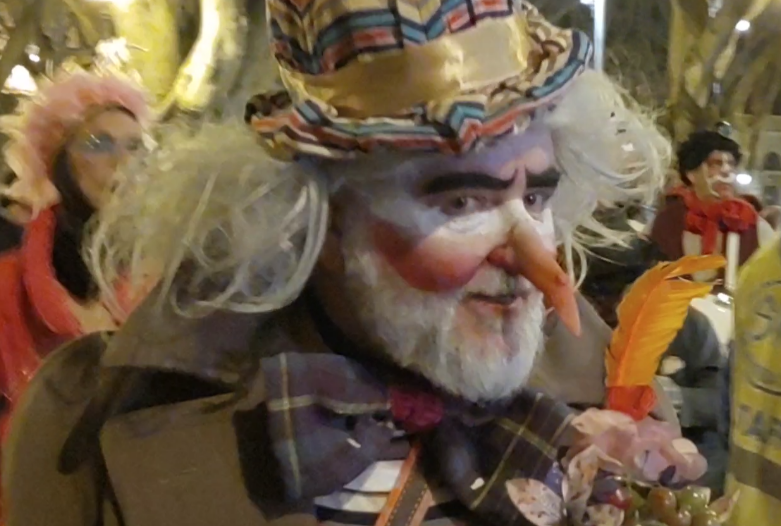
and connecting with their community.
The festive spirit of the celebration carried us down the streets to a piazza where the crowd enthusiastically chanted to the rhythm of the drums.
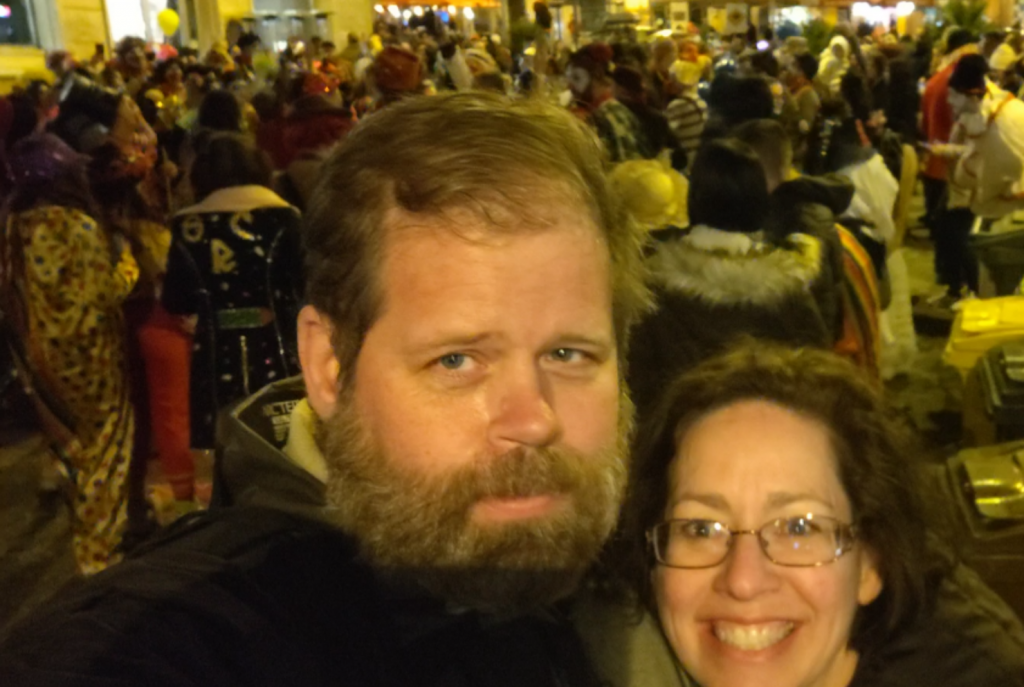
Their focused energy was hypnotizing!
We learned that they were reciting Sardinian nursery rhymes. We’d never experienced this amount of passion from a large group of people. We wanted to learn more about their motivation. What would bring this community together with such intensity? European “Carne val” is unlike anything we’d ever witnessed and we will always cherish this memory.
How did “Carne val” come to New Orleans?
Carnival (Carne val) started in Rome and Venice. By the 1700’s these customs were embraced in France calling it “Boeuf Gras,” or fatted calf.
On March 2 in 1699 when Jean Baptiste La Moyne Sieur de Bienville (a French explorer) arrived south of New Orleans, he named the the spot “Pointe du Mardi Gras.” It was a Tuesday, the day before “Boeuf Gras.” Mardi is ‘Tuesday’ and Gras means ‘fat.’ There you have it, “Fat Tuesday” or Mardi Gras!
In 1711 a group of men, the “Boeuf Gras Society,” would march through the streets with a bull’s head on a cart. Years later they used a live bull draped with a white cloth to symbolize the beginning of fasting from meat. The “Boeuf Gras Society’s” annual processions continued through 1861.
By the mid 1700’s elegant balls were initiated along with the processions as the standard practice for this period before Lent. Numerous groups were formed to organize the Mardi Gras Carnival. Even as the Spanish took over Louisiana in the later part of the century the French still influenced many traditions.
“Flambeaux,” (gaslight torches) lit the parades of carriages and horseback riders in the 1830’s. Tableaux cars were the floats of the day. A tableaux is a quick scene where actors are frozen in time. These riders would switch scenes in a choreographed pattern setting up unique peeks into their story as the carriage would pass the crowds.
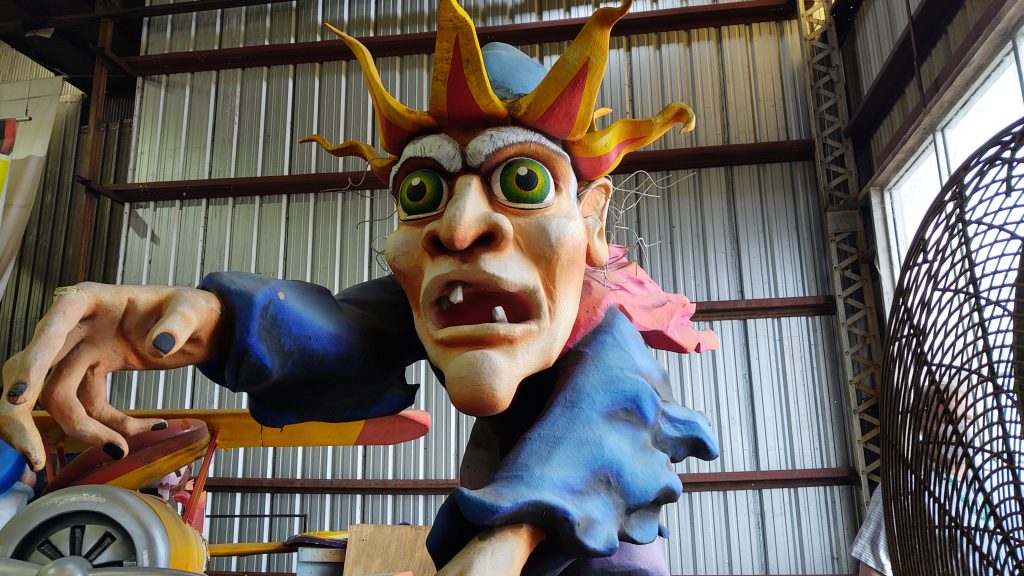
“Mistick Krewe of Comus,” the oldest, continuous organization started in 1856. They have featured John Milton’s hero, Comus, as a magical representation of their organization.
The secret society krewe members pay dues covering the costs for their club’s floats, costumes and gala balls. The parades have been free for the public. Corporate sponsorships are not allowed.
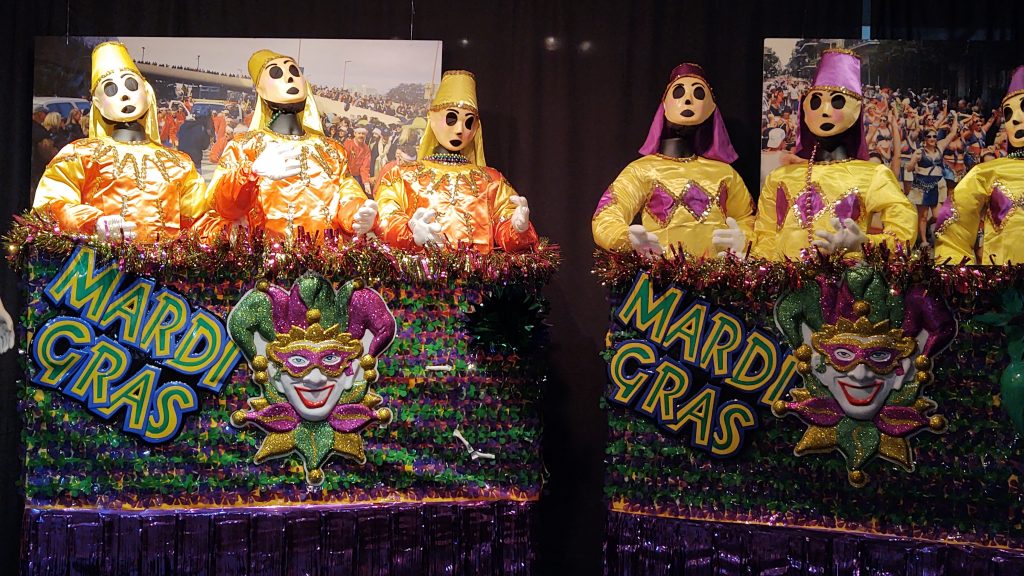
The first recorded “throwing of objects” was in 1870. They are known to toss items to audience members who make them happy. Audience participation is an exciting part to Mardi Gras!
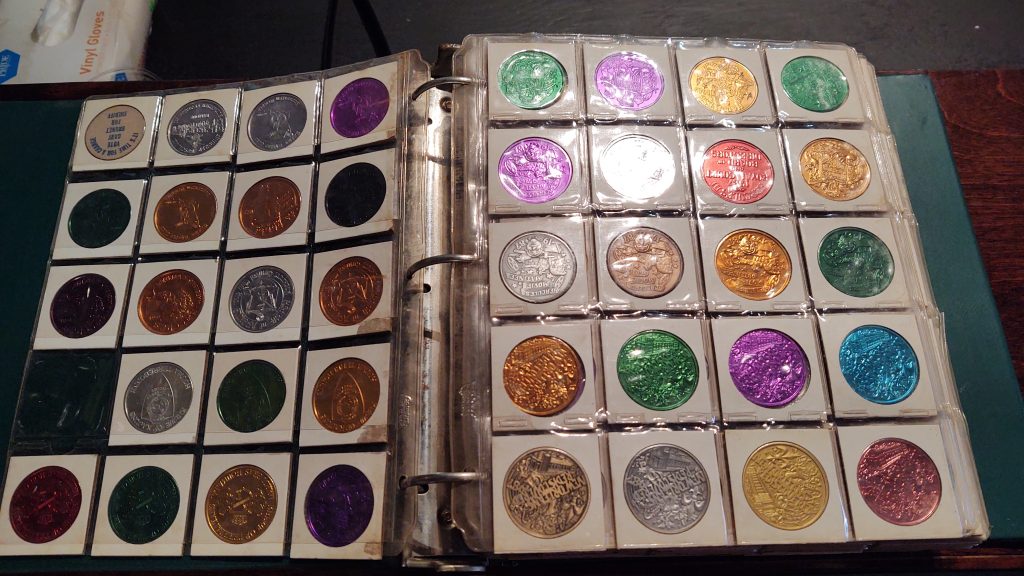
There are specialty throw items made by different krewes. Some examples are decorated coconuts, high heeled glittery shoes, designer plungers and ONE holy grail from Krewe King Arthur. The costumed parade observers create an uproar as they attempt to gain the masked float riders’ attention in hopes of earning a specialty throw.
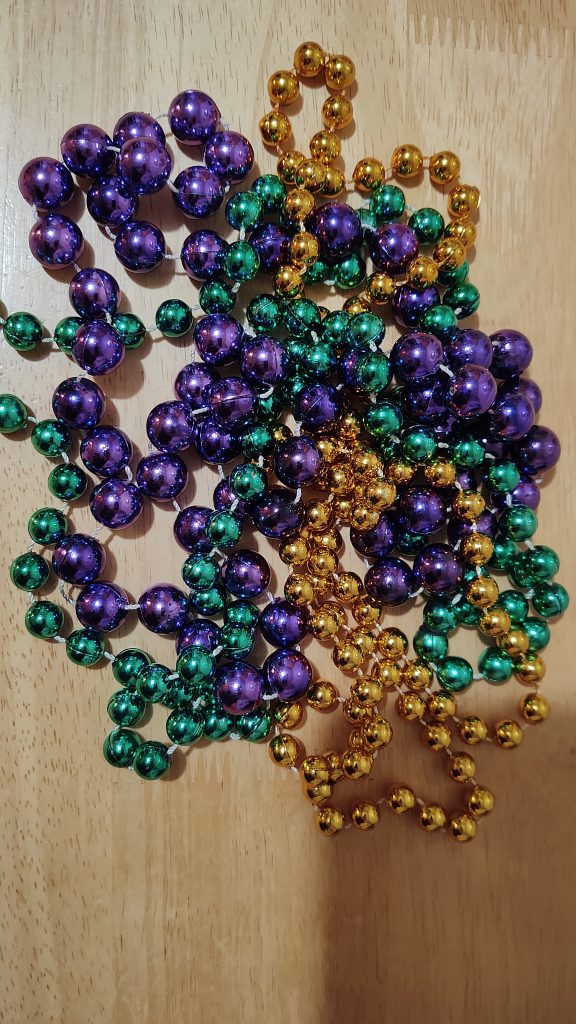
and Green = Faith
Why are the Mardi Gras colors purple, gold and green? Well, a group of businessmen wanted to impress the Russian Duke Alexis Romanoff in 1872 by using his family colors. These colors are still used today as the official Mardi Gras symbols of justice, power and faith.
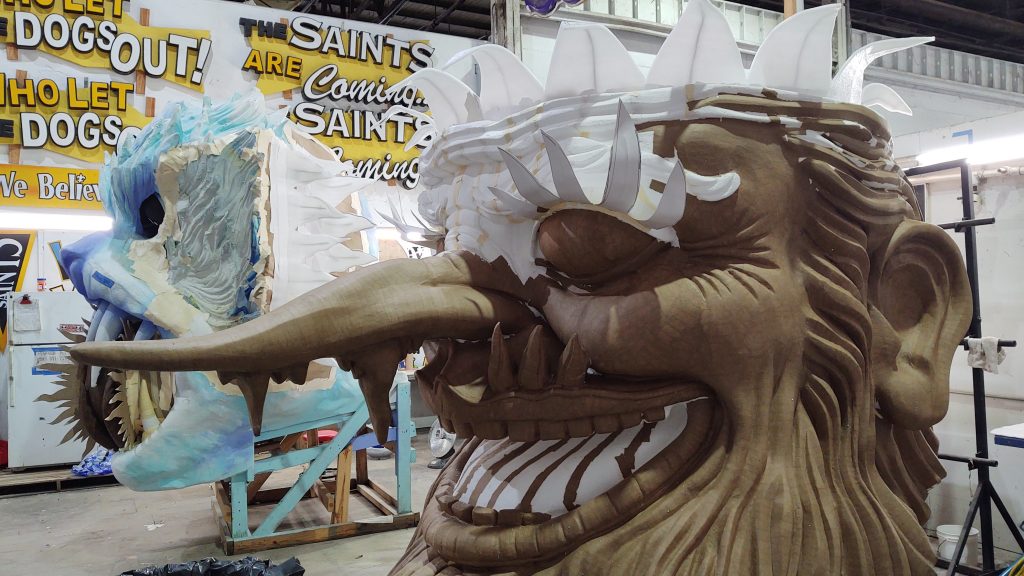
For forty years George Soulie’ used Parasian paper-mache’ to give life to the float designs by Carlotta Bonnecase, Charles Briton and B.A. Wikstrom.
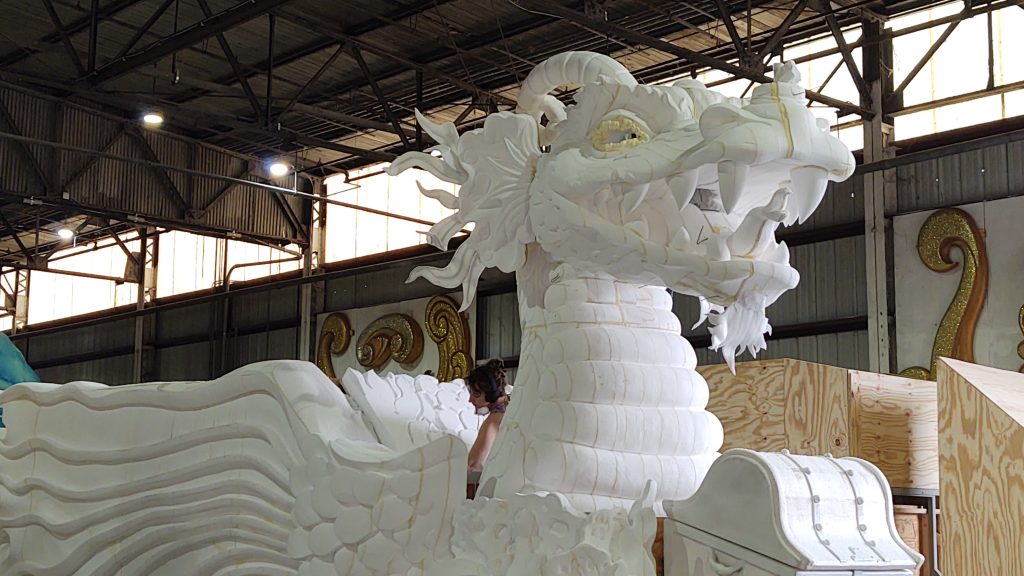

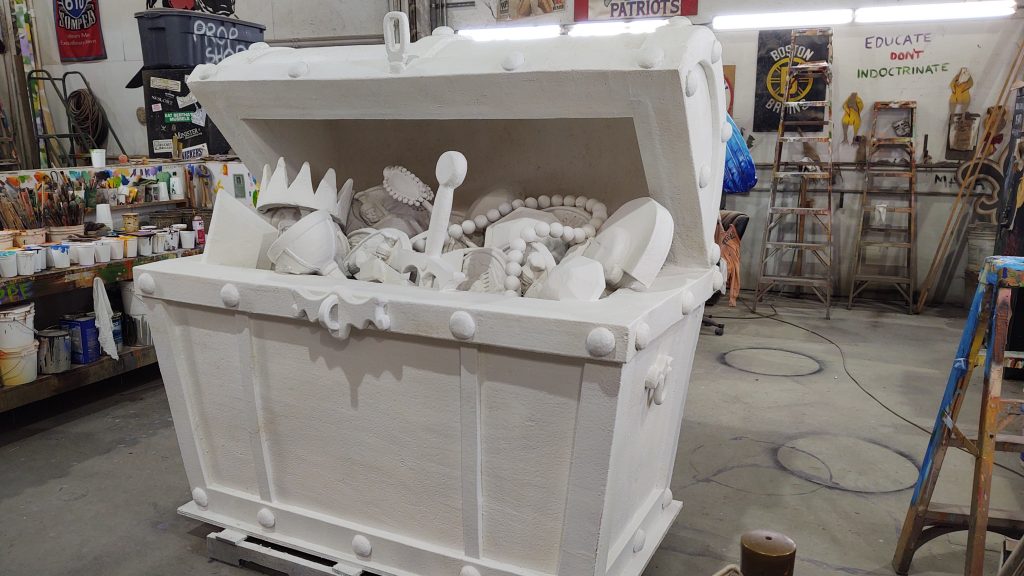
Fat Tuesday became a legal holiday in 1875 by Governor Warmoth. “The Mardi Gras Act” is followed today as all non-essential businesses close for the celebrations.
Blain Kern, known as Mr. Mardi Gras, got his start in float construction in 1945. He had offered to paint a mural of the history of medicine at a hospital to help pay for his mother’s medical bills. This painting caught krewe Alla’s captain’s eye. He happened to be a doctor at the hospital and asked the Kern to create and construct 11 floats for the 1946 parade.
Darwin Fenner, another captain of the well-known Rex organization, paid for Blain Kern to study Carnival traditions in Europe. “He was like a daddy to me.” said Kern.
Walt Disney approached Blain Kern with a job offer in 1959. It is said that Darwin Fenner encouraged Blain to stay in New Orleans. Blain continued to create more impressive floats including fiber optics and smoke.
At 93, Blain Kern passed away in his home on June 25, 2020. His wife said, “He was like Peter Pan and I am Tinkerbell.” He left an amazing legacy!
This fantasy wonderland of oversized characters brought out the six year old in me!
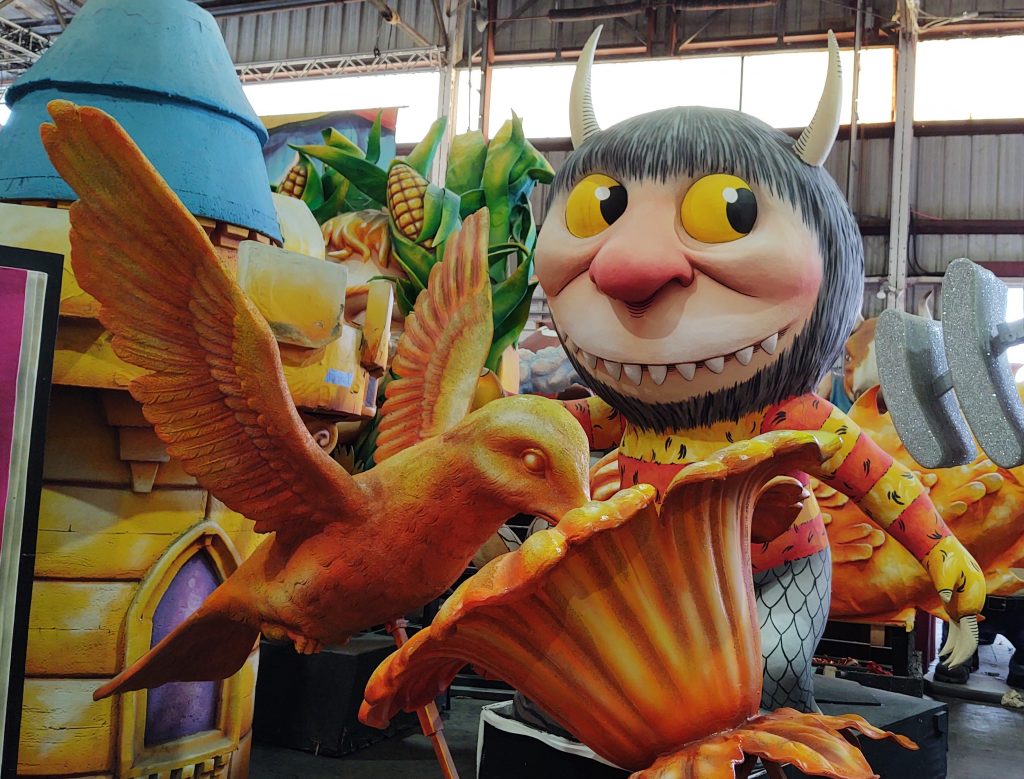
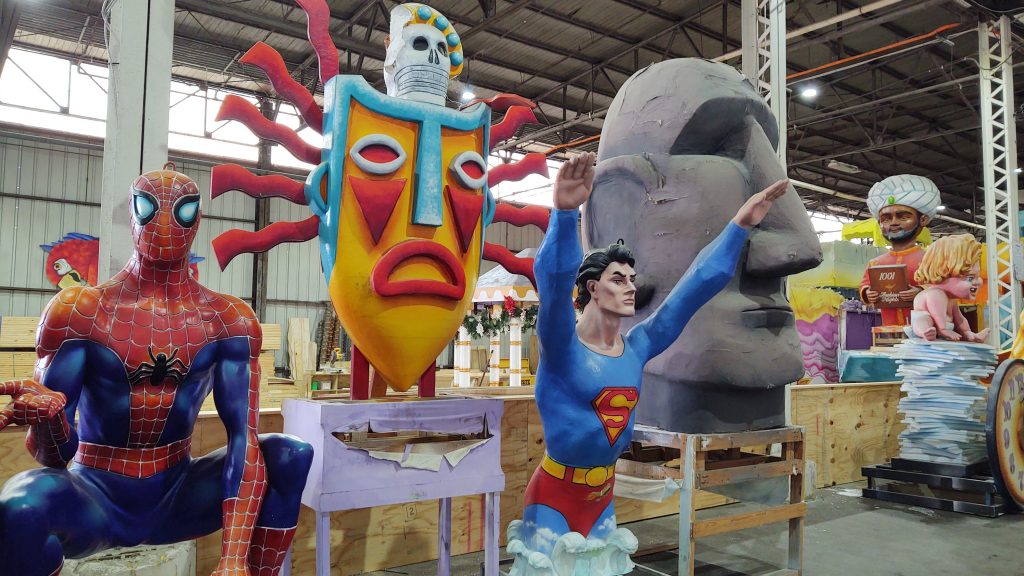
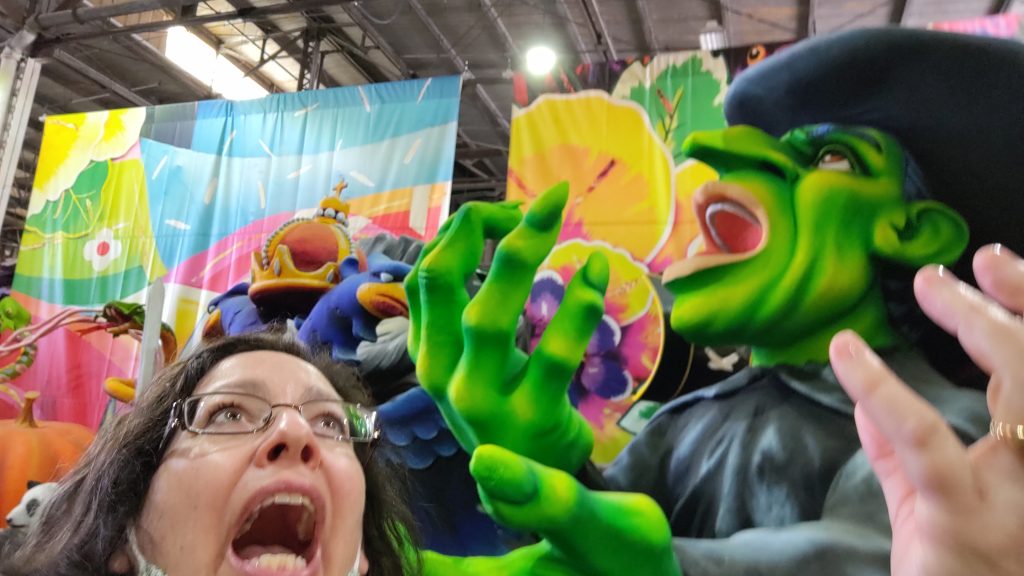
Blain Kern’s witch and I bonded.
In 1991 the city passed a law that all social organizations including Mardi Gras krewes had to certify that they didn’t discriminate in order to obtain permits necessary to walk in parades or other public events.
The three largest krewes, Orpheus, Barchus and Endymion appreared to struggle with this new law. The “Mistick Krewe of Comus” (the oldest) refused to reveal their traditionally secret membership of its club and stopped participating in the annual parade. It still holds a Mardi Gras ball. Later I learned that some of these krewes were underfunded and the 1991 law made it easier for them to step out of the parade circuit.

Later in the week I asked Tyrone, our personal guide, about the Mardi Gras Krewe law and how he felt about it. He explained, “The law changed the narrative. There were whites riding on the Zulu floats.” (Zulu Krewes typically consists of African Americans.) After a short pause, “The krewes help the community. They hire high school bands. The money supports the kids.” He said, “We’re all one here! There’s some black krewes, white krewes and Native American krewes. They are movers and shakers of politics, sure, but they all respect each other.”
The energy of the crowds during Mardi Gras is electric! The passion of the krewes to celebrate and entertain is generous! The audience participation with costumes and cheering is captivating. Check out New Orleans, the Crescent City, for a festive fervor you will remember forever.
Resources:
Tyrone – our guide 1-504-756-4411
Carl – our tour guide at Mardi Gras Museum of Costumes and Culture
Blain Kern’s Mardi Gras World – 1380 Port of New Orleans Place
Caglari, Sardinia February 2020
https://mardigrastraditions.com/blaine-kern/
https://www.mardigrasneworleans.com/history/
https://www.ice.org.uk/what-is-civil-engineering/what-do-civil-engineers-do/new-orleans-floodgates


